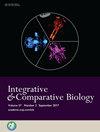The hawkmoth proboscis: an insect model for sensorimotor control of reaching and exploration
IF 2.2
3区 生物学
Q1 ZOOLOGY
引用次数: 0
Abstract
Reaching and inspecting objects is an intricate part of human life, which is shared by a diversity of animals across phyla. In addition to appendages like legs and antennae, some insects use their mouthparts to reach and inspect targets. Hawkmoths of the family Sphingidae (Lepidoptera) use their extremely long and straw-like proboscis to drink nectar from flowers. As they approach flowers, hawkmoths uncoil their proboscis and explore the floral surface while hovering to target the proboscis to the nectary hole. Several sensory modalities provide feedback to control and guide these extremely versatile proboscis movements. The control task faced by the hawkmoths’ nervous system during such behaviors in not unlike that of an animal guiding limbs or a robotic agent guiding a manipulator to a target. Hawkmoths perform these reaching maneuvers while simultaneously hovering, and hence require rapid and continuous coordination between the proboscis, neck and and flight motor systems, thereby providing a unique invertebrate model for studying appendage guidance and reaching. Here, we review what is known about how hawkmoths use their proboscis for floral inspection and nectar discovery, as well as the role of various sensors in proboscis guidance. We give a brief overview of the morphology and muscular apparatus of the hawkmoth proboscis, and discuss how multimodal sensory feedback might be turned into motor action for appendage guidance.鹰蛾的长鼻:昆虫伸手和探索的感觉运动控制模型
够取和检查物体是人类生活中错综复杂的一部分,也是各门类动物的共同特点。除了腿和触角等附肢外,一些昆虫还使用口器来触及和检查目标。鳞翅目鹰蛾科的鹰蛾用其极长、像吸管一样的长鼻喝花蜜。当它们接近花朵时,鹰蛾会松开探针并探索花朵表面,同时盘旋将探针对准蜜腺孔。多种感官模式为控制和引导这些极为多变的探针运动提供反馈。鹰蛾的神经系统在这种行为中面临的控制任务与动物引导肢体或机器人引导操纵器到达目标并无二致。鹰蛾在悬停的同时进行这些伸手动作,因此需要长鼻、颈部和飞行运动系统之间快速而持续的协调,从而为研究附肢引导和伸手动作提供了一个独特的无脊椎动物模型。在此,我们回顾了目前已知的有关鹰蛾如何利用其探针进行花朵检查和发现花蜜的知识,以及各种传感器在探针引导中的作用。我们简要概述了鹰蛾探针的形态和肌肉装置,并讨论了如何将多模式感觉反馈转化为附肢引导的运动动作。
本文章由计算机程序翻译,如有差异,请以英文原文为准。
求助全文
约1分钟内获得全文
求助全文
来源期刊
CiteScore
4.70
自引率
7.70%
发文量
150
审稿时长
6-12 weeks
期刊介绍:
Integrative and Comparative Biology ( ICB ), formerly American Zoologist , is one of the most highly respected and cited journals in the field of biology. The journal''s primary focus is to integrate the varying disciplines in this broad field, while maintaining the highest scientific quality. ICB''s peer-reviewed symposia provide first class syntheses of the top research in a field. ICB also publishes book reviews, reports, and special bulletins.

 求助内容:
求助内容: 应助结果提醒方式:
应助结果提醒方式:


